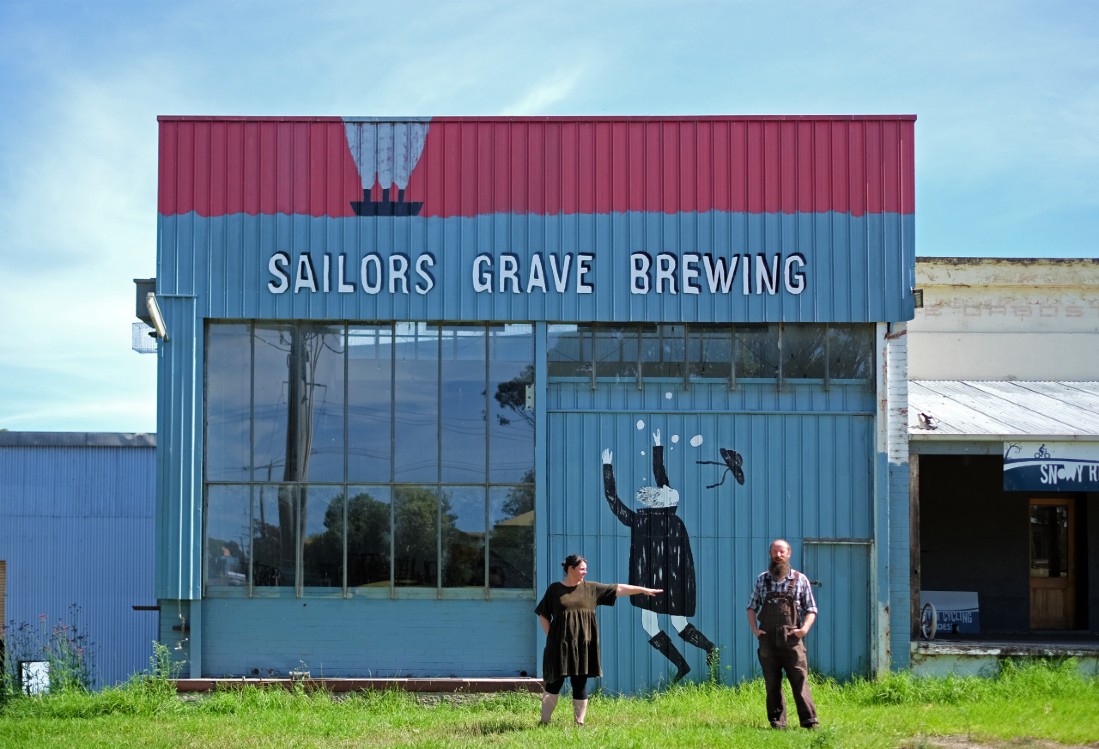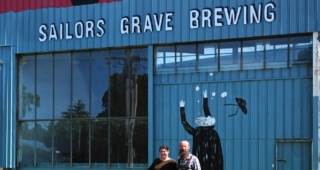When you make a beer with long-spined sea urchin your hands become stained a deep shade of purple for days. Scores of cracked shells bulging with mildly venomous black needles, bags of blended urchin guts hung in boiling wort, the brewery doubles as a killing floor sheathed by the pungent aroma of briny, brackish ocean. And when the day is done, clearing away the carnage from 150 or so deposed urchins is a bloody awful affair.
What is left in the wake of this stinking spectacle, however, is something delicate, something elegant; a tart, slightly sour beer that speaks at once to both the surrounding land and sea that are so fundamental to its subtle complexion. “If it tasted strongly of sea urchin, I think we would have failed; it would have been a gimmicky beer,” says Chris Moore, who with his partner Gab co-founded Sailors Grave Brewing in 2016. “It just has to add an oceany touch.”
Originally made for the Wild Seafood Festival in Mallacoota, Uni is a 4.5% gose brewed with urchin and a scented flowering plant endemic to the area called lemon myrtle. Budawang Elder of the Yuin Nation Noel Butler and his partner Trish foraged the plant, which the Moores say give the beer balance. They add it as soon as fermentation is complete, circulating it through with a colander just long enough to impart floral whiffs of citrus.
“We very much approach beer like you would cooking. We believe in lots of layers and complexity in beer, but also subtlety—nothing should dominate, nothing should be too much in your face,” Chris says. “If it works in food it almost always can work in beer, with some exceptions.”
A local diver harvests the urchins the morning of the Uni brew day, then trucks them straight to the Sailors Grave brewery in Orbost, a tiny town in the Shire of East Gippsland, about 230 miles east of Melbourne. Finding these black, spiky urchin (Centrostephanus rodgersii) off the tip of Australia’s rugged southeastern coast isn’t much of a problem these days, which is a problem.
Native to New South Wales and some parts of New Zealand, the species has over the past few decades gradually moved south towards Tasmania, gobbling kelp and other seaweed along the way and comfortably breeding in waters warming four times faster than the global average. At the same time large rock lobster—the urchins’ greatest predator—have become overfished. These invasive urchin now pose a real threat to the area’s rich marine biodiversity.
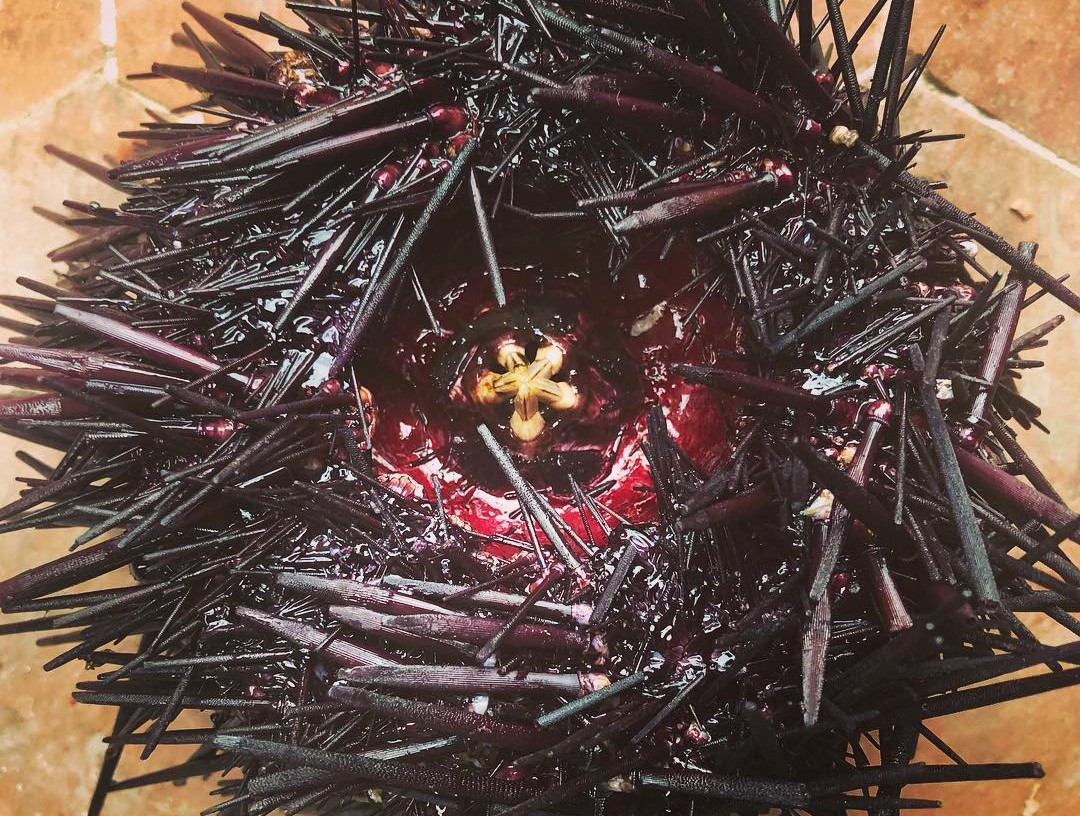
“They’re a massive pest, especially down the coast where we are,” says Gab. “In their offseason abalone divers are paid to go out there and kill sea urchins on the sea floor—they don’t even bring them up. So this is essentially an ‘eating the problem’ beer.”
After the Moores shuck the urchins they’re added to the wort about five minutes before the boil is done. “This doesn’t sound very nice, but we experiment a little bit with some of the guts because they’re really so oceany,” says Chris. “So we blend them up, hang them in a mesh bag in the kettle right at the end, then pour all the juices in.”
Related: Last Pour — Bonus Quotes from Sailors Grave Brewing
For now the labor-intensive Uni is a seasonal beer, one that’s part of a planned series of collaborations with the Butlers and other members of local indigenous tribes. “We find collaboration is a great way to spark the fires of innovation,” Chris says. “Our imagination is always going to come up against brick walls unless we’re really engaging with the environment we live in and with other people.”
“Otherwise we’re just sitting out here in our little hillbilly town.”
Down on the Farmland
Spanning more than 8,000 square miles, the Shire of East Gippsland is a heavily forested, minimally inhabited coastal area located in the far eastern corner of Victoria. The shire’s largest town, Bairnsdale, has just more than 15,000 residents—population-wise that’s more than five times the size of Orbost. This lack of people and abundance of nature is part of the town’s lure.
Orbost is a one-time logging giant that has in recent years become an increasingly popular tourist destination. Sat on the banks of the Snowy River, which winds south for some 220 miles from Australia’s highest mountain, Mount Kosciuszko, Orbost is a jump-off point for beaches to the south and several national parks in all directions. Cyclists come, too, many of them drawn by the 58-mile East Gippsland Rail Trail, which tracks the now-dismantled railway line that once connected Orbost with Bairnsdale.
The appeal, that is, isn’t so much what’s within Orbost itself, but rather what encompasses it.
Sailors Grave Brewing may be the lone exception (aside from the highly rated Orbost Visitor Information Centre, which I’m sure is genuinely splendid, but, well). It occupies the site of an old butter factory—“a pretty shambolic old building,” says Chris—that was built in the 1890s and had basically been left to rot after production ended in the late 1970s. The Moores saw the site’s advanced decay, sure, but also its character, its history. It helped that the site was practically ready-made for a brewery, too, with drainage systems and floors built to accommodate massive tanks.
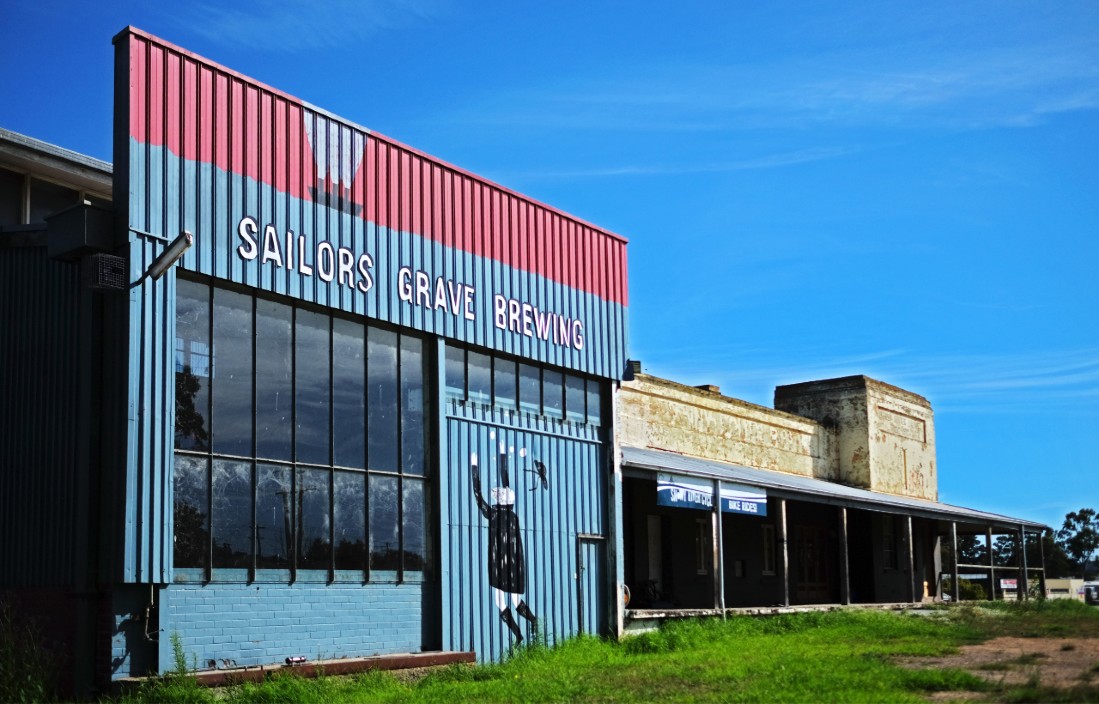
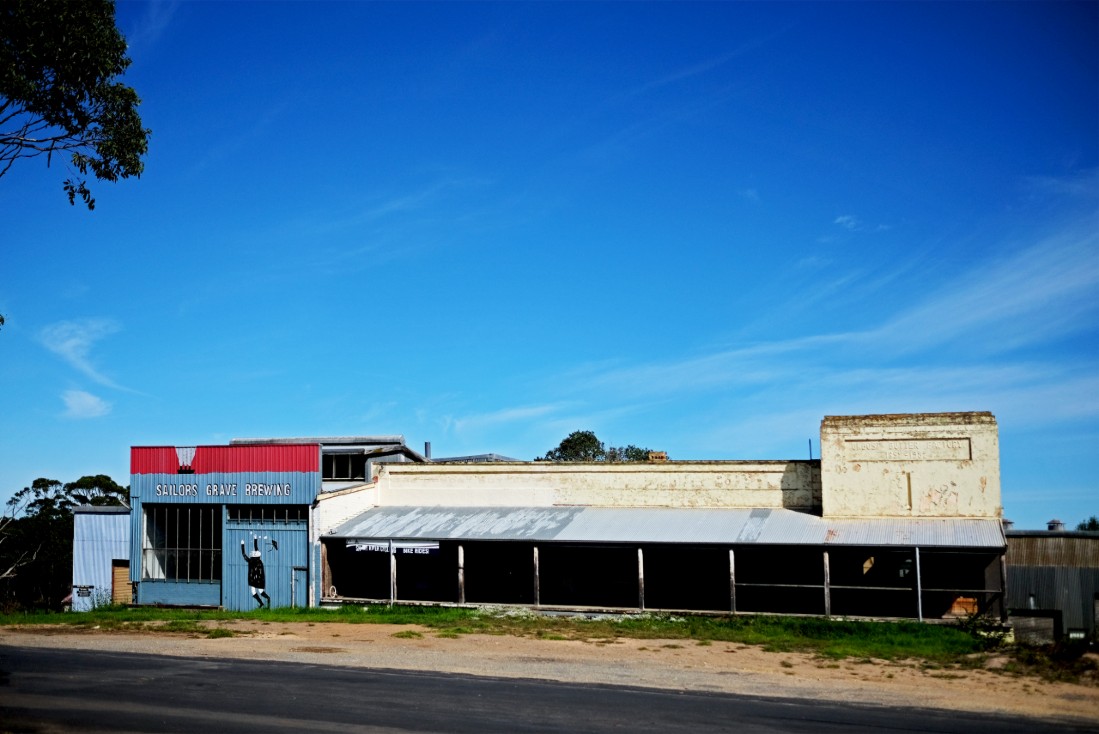
“It was just by chance that I was driving around town looking for big enough sheds for a brewery, saw the old butter factory, and thought I’d just give them an email and see,” says Gab. “And the rest is history. It was sitting there doing absolutely nothing, and we are really lucky to have ended up there.”
How the Moores ended up in Orbost—or in Gab’s case, back in Orbost—is another story. Gab grew up in the area, but before Sailors Grave she and Chris ran a bar and restaurant in Sydney. After a while lifestyle change beckoned, so they sold the place and fled to the United States, spending about three months crisscrossing the continent and finding plenty of time to visit “small breweries in the middle of nowhere,” says Gab. Places like Jolly Pumpkin Artisan Ales in Dexter, Michigan, and Jester King Brewery outside of Austin, Texas.
Related: Optimists Prime — Moon Dog Brewing Thinking Big in Melbourne, Australia
The fingerprints of one brewery in particular, the now world-renowned Hill Farmstead Brewery in North Greensboro, Vermont, are all over Sailors Grave. “We were looking for the brewery, which was down this dirt track, it was snowing and sleeting, I thought we were lost, and then cars started piling up along the road and I was like, ‘wow, this is amazing,’” says Gab. “That made me realize that if you’ve got a great product you can make it anywhere, set up anywhere.”
“We decided we wanted to have the brewery on the farm where we live. Regulatory problems held us back, but I still want to fulfill that dream of moving back to the farm and having a farm brewery, like a Hill Farmstead or a Jester King. That’s the ultimate dream.”
Where the Wild Things Are
Although Sailors Grave isn’t ready to physically relocate to the Moore family farm, it’s already there in spirit. Scan the brewery’s growing list of seasonal brews and you’ll see a consistent, concerted focus on farmhouse ales and other beers that use local fruits and flora. Marigold, elderflower, hay, carrot seed flowers, kumquat, wormwood leaves, sea figs, saltbush—almost anything native to the Gippsland region has a good chance to find its way into a beer here.
This quasi-naturalist approach to brewing has engendered a cult following for Sailors Grave in a fairly short time. Importantly it maintains steady distribution in “nearby” volume vacuums Melbourne and Sydney, and now exports to New Zealand, Hong Kong, Japan, and Singapore. This is still a small-batch brewery, though, with just one full-time brewer and a few part-time packagers helping the Moores run things as Sailors Grave produces up to 250,000 liters a year.

For all the early success in big cities near and abroad, earning the approval and support of the local community has always been essential for the Moores. In that regard, Sailors Grave has endured more of what Gab calls a “slow burn” as locals new to craft beer gradually dipped their toes into the brewery’s range of somewhat unconventional beers. And by gradually, I mean it took almost three years for Orbost’s two pubs to put Sailors Grave on tap.
“We made it hard for ourselves. We didn’t open with say a pale ale and wheat beer, and the things they would expect of us. I guess we were pretty stubborn in that way,” says Gab. “Other than Drowned Man IPA, our first beer was a gose with seaweed. It’s an incredibly subtle beer, but it’s really out there as an idea for people. We knew we had to work our way backwards by getting successful in the cities, then letting that success back filter until word reached Orbost.”
It’s not like everything here lands on the esoteric side of craft. Sailors Grave’s core range, for instance, includes the humble 4.8% lager Sou’east Draught, as well as the dry, slightly juicy Drowned Man, a session IPA brewed with Idaho #7, Simcoe, and Vic Secret hops. You won’t find many other square shooters, though beer makeup lies in the eye of the beholder.
Related: Five Questions with Wildflower Brewing & Blending’s Topher Boehm
“Using weeds isn’t really that strange. It’s maybe strange now, but back when they first started making beer it was women brewing in farmhouses, and they would pick botanicals from the fields to bitter the beer,” Gab says. “The most challenging beer we’ve ever done is our Spring Farmhouse, which used a saison yeast and foraged nettles, dandelions, milk thistle—lots and lots of weeds. It’s extremely weedy and people love it; they’ll buy kegs of it.”
The Moores’ experimental brewing methods extend to fermentation. They’ve done several beers that swapped traditional beer yeast for wine lees, sake lees, wild yeasts, and even nettles, the latter a flowering plant sometimes used in teas, foods, and alternative meds.
Sailors Grave has thus far released four different versions of its annual sake beer, fermenting each one with sake lees sourced from a different brewer. “You wouldn’t believe the difference in the journey that each beer takes us on,” says Gab. “It’s completely unpredictable, but the flavors that come every time from those sake lees are one of the best flavors I’ve ever had in a beer.”

Rhubarb Harvest Ale, a collaboration with Lightfoot & Sons Wines in Calulu, uses rhubarb from the Moores’ farm and foraged fennel pollen, then is fermented on lees left over in chardonnay barrels from the winery. The pollen is the last ingredient in, spending about two days in the tank. Gab says it’s more effective than the seed and gives the beer a creamy component. “It’s one of my favorite beers to make because when I go pick the fennel pollen I fill the back of the van with it, and the whole van gets full of ladybugs,” Gab says. “Bugs everywhere in the van and then back in the brewery; it’s just covered in life. It’s so beautiful.”
Chris agrees. “I love that beer because it sums up what we do a lot,” he says. “It’s about community and collaboration, flavor layers, foraged ingredients, local ingredients from our farm—it’s just the kind of beer we love to make.”
“And I love how it tastes, too.”
###
Sailors Grave Brewing is based in Orbost, Victoria, Australia. The brewery is not open to the public, but its beers are all over Australia. Smith Street Trading Co imports and distributes Sailors Grave in Singapore.
All photos taken by Kim Choong (except where indicated) and cannot be reused.
Full Disclosure: To preview its debut shipment from Sailors Grave Brewing, Smith Street Trading Co provided a mixed pack of four beers prior to our call with the brewery. While this did not influence our coverage, Beer Travelist believes in transparency – unlike other media in Singapore.


